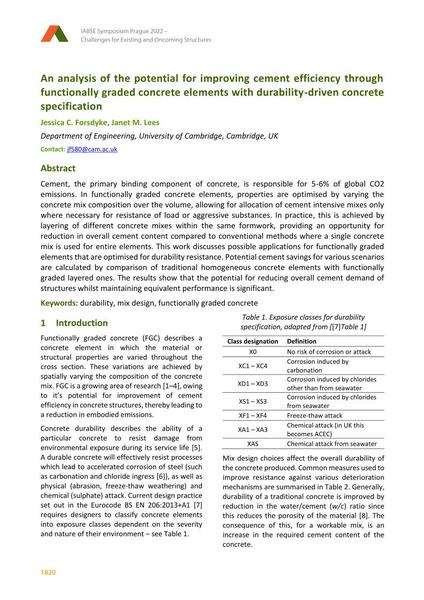An analysis of the potential for improving cement efficiency through functionally graded concrete elements with durability-driven concrete specification

|
|
|||||||||||
Détails bibliographiques
| Auteur(s): |
Jessica C. Forsdyke
(Department of Engineering, University of Cambridge, Cambridge, UK)
Janet M. Lees (Department of Engineering, University of Cambridge, Cambridge, UK) |
||||
|---|---|---|---|---|---|
| Médium: | papier de conférence | ||||
| Langue(s): | anglais | ||||
| Conférence: | IABSE Symposium: Challenges for Existing and Oncoming Structures, Prague, Czech Republic, 25-27 May 2022 | ||||
| Publié dans: | IABSE Symposium Prague 2022 | ||||
|
|||||
| Page(s): | 1820-1829 | ||||
| Nombre total de pages (du PDF): | 10 | ||||
| DOI: | 10.2749/prague.2022.1820 | ||||
| Abstrait: |
Cement, the primary binding component of concrete, is responsible for 5-6% of global CO₂ emissions. In functionally graded concrete elements, properties are optimised by varying the concrete mix composition over the volume, allowing for allocation of cement intensive mixes only where necessary for resistance of load or aggressive substances. In practice, this is achieved by layering of different concrete mixes within the same formwork, providing an opportunity for reduction in overall cement content compared to conventional methods where a single concrete mix is used for entire elements. This work discusses possible applications for functionally graded elements that are optimised for durability resistance. Potential cement savings for various scenarios are calculated by comparison of traditional homogeneous concrete elements with functionally graded layered ones. The results show that the potential for reducing overall cement demand of structures whilst maintaining equivalent performance is significant. |
||||
| Copyright: | © 2022 International Association for Bridge and Structural Engineering (IABSE) | ||||
| License: | Cette oeuvre ne peut être utilisée sans la permission de l'auteur ou détenteur des droits. |
||||
